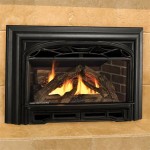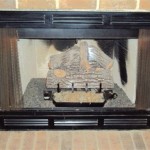Mosaic Tile Fireplace Surround: A Timeless and Customizable Hearth
The fireplace, for centuries, has served as a focal point within the home, providing warmth, a sense of gathering, and aesthetic appeal. Enhancing the visual impact of a fireplace is often achieved through the use of a surround. Among the myriad of materials available for this purpose, mosaic tile stands out as a particularly versatile and visually striking option. The enduring appeal of mosaic tile lies in its inherent flexibility, allowing for a wide range of design interpretations and the ability to seamlessly integrate into diverse architectural styles.
A mosaic tile fireplace surround involves covering the area surrounding the fireplace opening with small pieces of tile arranged in a pattern or design. These tiles can be made from a variety of materials, including ceramic, porcelain, glass, stone, and even metal. The individual tiles, often referred to as tesserae, are typically mounted on mesh sheets for ease of installation. The resulting mosaic can range from simple, geometric patterns to intricate, pictorial representations, providing a canvas for personal expression within the home.
The decision to incorporate a mosaic tile fireplace surround involves considering several factors, including the overall aesthetic of the room, the desired level of maintenance, and the budget allocated for the project. It’s a project that can range from a relatively simple DIY undertaking to a complex, custom installation requiring professional expertise. Regardless of the approach taken, the installation of a mosaic tile surround can significantly enhance the visual appeal and perceived value of a fireplace.
Key Point 1: Design Versatility and Aesthetic Impact
The principal advantage of using mosaic tile for a fireplace surround resides in its unparalleled design versatility. Unlike larger, monolithic materials, mosaic tiles offer the opportunity to create intricate patterns, color gradients, and textural variations that are impossible to achieve with other options. This inherent flexibility allows homeowners to tailor the fireplace surround to perfectly complement their existing décor or to establish a unique design statement.
Consider the range of stylistic possibilities. For a traditional home, a mosaic surround might feature intricate floral patterns or classical motifs, rendered in earthy tones of ceramic or stone. In a modern setting, a geometric design using glass or metal tiles in bold colors can create a striking, contemporary focal point. The choices are virtually limitless, constrained only by the imagination and the skill of the installer. The ability to blend different materials, colors, and tile sizes further expands the design possibilities, allowing for the creation of a truly bespoke fireplace surround.
Furthermore, mosaic tiles can be used to create visual illusions, such as adding depth or height to a room. A vertical mosaic pattern can draw the eye upwards, making a low-ceilinged room appear taller. Similarly, a strategically placed mosaic border can define the fireplace area and create a sense of visual separation from the surrounding wall. The ability to manipulate light and shadow through the use of different textures and finishes adds another layer of design complexity, allowing for the creation of a surround that is both visually appealing and subtly transformative.
The impact of a mosaic tile surround extends beyond mere aesthetics. A well-designed surround can significantly increase the perceived value of a home by transforming a functional element into a work of art. It also provides an opportunity to personalize the living space and create a unique expression of individual style. The enduring appeal of mosaic tile ensures that the investment in a mosaic fireplace surround will continue to add value and enjoyment for years to come.
Key Point 2: Material Options and Performance Characteristics
The selection of materials for a mosaic tile fireplace surround is a critical factor that directly impacts both the aesthetic appearance and the performance characteristics of the finished product. Each material offers unique advantages and disadvantages in terms of durability, heat resistance, maintenance requirements, and cost. Understanding these differences is essential for making an informed decision.
Ceramic Tile: Ceramic tile is a popular choice due to its affordability, wide availability, and diverse range of colors and patterns. It is relatively easy to install and maintain, and it offers good resistance to heat and moisture. However, ceramic tile is more porous than other options and may be susceptible to staining if not properly sealed. Its durability is also somewhat lower than porcelain or stone tiles.
Porcelain Tile: Porcelain tile is a denser and more durable alternative to ceramic tile. It is fired at a higher temperature, resulting in a less porous and more resistant material. Porcelain tile is highly resistant to staining, scratching, and moisture, making it an excellent choice for high-traffic areas or environments with heavy use. While it is generally more expensive than ceramic tile, its superior performance characteristics often justify the increased cost.
Glass Tile: Glass tile offers a unique aesthetic appeal due to its translucent quality and ability to reflect light. It is available in a wide range of colors and finishes, from iridescent to matte. Glass tile is non-porous and resistant to staining, making it easy to clean and maintain. However, it is generally more expensive than ceramic or porcelain tile, and it can be more challenging to install due to its smooth surface and potential for chipping. It should be noted that not all glass tiles are rated for fireplace use and careful attention needs to be paid to the manufacturer's guidelines and suitability for high heat applications.
Stone Tile: Stone tile, such as marble, granite, and slate, offers a natural and luxurious aesthetic. Each stone has unique veining and variations in color, adding character and depth to the fireplace surround. Stone tile is durable and resistant to heat, but it is also porous and requires regular sealing to prevent staining. It can be more expensive than other options, and installation may require specialized tools and techniques.
Metal Tile: Metal tile offers a contemporary and industrial aesthetic. It is available in a variety of metals, such as stainless steel, copper, and bronze, each with its own unique color and texture. Metal tile is durable and resistant to heat, but it can be susceptible to scratching and tarnishing. It is also typically more expensive than other materials and may require specialized cleaning products.
When choosing a material for a mosaic tile fireplace surround, it is important to consider the specific requirements of the fireplace and the surrounding environment. Factors such as the type of fuel used in the fireplace, the proximity of the tile to the firebox, and the level of humidity in the room should be taken into account. Consulting with a professional tile installer can help to ensure that the chosen material is appropriate for the intended application and will provide long-lasting performance.
Key Point 3: Installation Considerations and Best Practices
The successful installation of a mosaic tile fireplace surround requires careful planning, meticulous execution, and adherence to industry best practices. Improper installation can lead to a variety of problems, including tile cracking, grout failure, and moisture damage. Whether the project is undertaken as a DIY endeavor or entrusted to a professional, understanding the key steps and considerations is crucial.
Surface Preparation: The first and arguably most important step in the installation process is surface preparation. The surface to which the mosaic tile will be applied must be clean, dry, and structurally sound. Any existing paint, wallpaper, or loose debris must be removed. If the surface is uneven, it should be leveled with a patching compound. For masonry fireplaces, a scratch coat of mortar may be necessary to provide a smooth and uniform surface. It is also important to ensure that the surface is properly primed to promote adhesion of the thin-set mortar.
Layout and Design: Before applying any mortar, it is essential to carefully plan the layout and design of the mosaic tile. This involves determining the placement of individual tiles, borders, and any decorative elements. A dry layout, where the tiles are arranged on the surface without mortar, allows for visual confirmation of the design and provides an opportunity to make adjustments before committing to the installation. It is also important to consider the grout lines and ensure that they are consistent and even throughout the surround.
Applying Mortar: The application of thin-set mortar is a critical step that requires precision and attention to detail. A high-quality thin-set mortar specifically designed for tile installation should be used. The mortar should be mixed according to the manufacturer's instructions and applied to the surface using a notched trowel. The size of the notch should be appropriate for the size and type of tile being used. The mortar should be applied evenly and consistently to ensure proper adhesion of the tiles.
Setting the Tiles: Mosaic tile sheets are typically mounted on mesh backing, which simplifies the installation process. The sheets should be carefully aligned and pressed firmly into the mortar. It is important to use a rubber grout float to gently tap the tiles and ensure that they are fully embedded in the mortar. Any excess mortar should be removed immediately with a damp sponge. It is also important to use tile spacers to maintain consistent grout lines between the sheets.
Grouting: Once the mortar has cured, typically after 24-48 hours, the grout can be applied. The grout should be mixed according to the manufacturer's instructions and applied to the grout lines using a grout float. The grout should be pushed firmly into the grout lines to ensure that they are completely filled. Any excess grout should be removed immediately with a damp sponge. After the grout has partially cured, it should be cleaned with a grout haze remover to remove any remaining residue.
Sealing: Depending on the type of tile and grout used, it may be necessary to apply a sealant to protect the surface from staining and moisture damage. The sealant should be applied according to the manufacturer's instructions and allowed to dry completely before using the fireplace. Regular cleaning and maintenance will help to ensure that the mosaic tile fireplace surround remains beautiful and functional for years to come.
It's important to consult local building codes and regulations before beginning any fireplace renovation project. Furthermore, for complex designs or if unfamiliar with tiling, engaging a qualified professional installer is highly recommended. A professional will ensure proper installation, preventing costly errors and guaranteeing the longevity of the mosaic tile fireplace surround.

Mosaic Fireplace Motawi Tileworks

Triangolo Mosaic Fireplace Surround Surrounds Tile

Cream Herringbone Stone Mosaic Fireplace Surround And Hearth Subway Tile

Custom Fireplace Mosaic You Customize Your Own Design And Size

Tile Mosaic Fireplace Surround Jkmosaic

Giving Your Fireplace An Ultimate Facelift With Mosaic Art

Fireplace In A 1x2 Marble Mosaic Tile Surround Remodel Living Room With

Fireplaces Tilehub

14 Fresh Designs For Tiled Fireplaces Bob Vila

Fireplaces Tilehub
Related Posts








